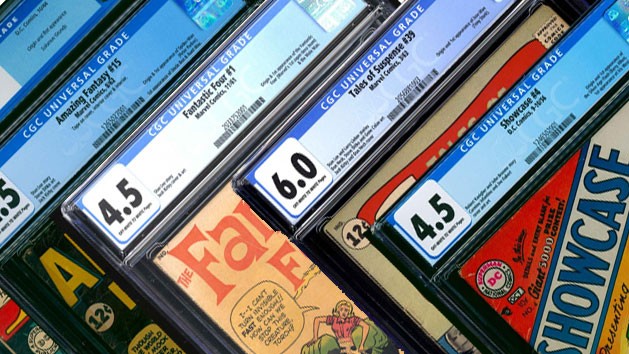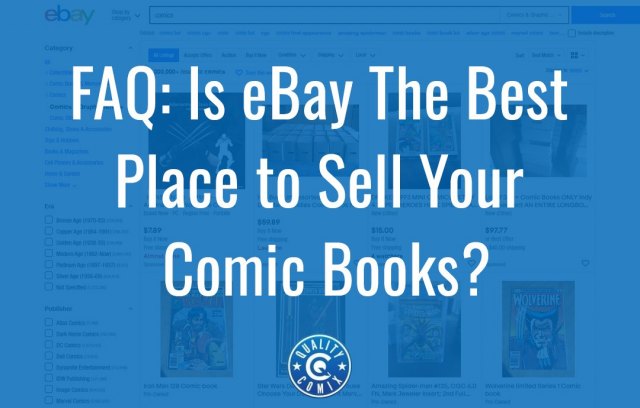
What is CGC comic grading? Is it worth the money? Let’s explore everything you need to know about this comic book grading service.
In the year 2000, the world of comic book grading was revolutionized when CGC Grading burst onto the scene. Since then, the comic book grading service has helped comic book collectors and sellers determine the value and worth of a particular comic book. Here, we’ll explore everything you need to know about CGC comic grading, whether it’s worth the money, and whether its competitors have more to offer.
Are you looking to sell your comics? We’re always on the lookout for vintage comic collections.
What Is CGC Comic Grading?
The CGC (Comics Guaranty Company) opened its doors and graded its first comics in early 2000. A highly respected comic dealer, Steve Borock, was hired to be CGC’s first primary grader and unofficial ambassador for certified grading.
Before CGC, the grading of comic books was left to individual dealers and collectors. There was never a consensus on what a grade would be and, subsequently, many collectors were taken advantage of by unscrupulous comic dealers, some of whom knew less about grading than the collectors did!
Nowadays, CGC is a great tool for both dealers and collectors alike. When thousands of dollars are involved, CGC is a great third-party arbiter of grade and value for comic book transactions. According to Gpanalysis.com, nearly $1 billion worth of CGC-graded comics have traded hands since 2002!
Related: GPAnalysis: Is the Comic Book Valuation Service Worth the Money?
What Is Restoration and What Does CGC Grading Have to Do with it?
Restoration is any alteration made to a comic book that attempts to improve its appearance. Examples of restoration include color touch, adding pieces to a comic, spine reinforcement, staple replacement, tear seals, and more. Prior to CGC’s existence, many dealers would not disclose restoration that had been done to a comic before its sale. When CGC started grading these comics, the collectors were unhappy to learn that their prized possessions were restorations, without being advertised as such. Many dealers went out of business during those early days because their customers caught onto their bad business practices.
How Does CGC Grade Comic Books?
CGC uses a standard 10-point grading scale to grade comic books. It doesn’t publicly release how it grades its comics, but as it has graded over 5 million comics since its inception, there are plenty of examples in different grades to gauge a book’s standard. Note that from 0.5 to 9.0, the grades are in 0.5 point increments. Then from 9.2 up to 10.0, they are in 0.2 or fewer increments. This is because the difference in value of expensive comics graded above 9.0 is so dramatic, so by breaking down the grade separation into smaller increments, collectors can better determine the right value.
10.0 Gem Mint
9.9 Mint
9.8 Near Mint/Mint
9.6 Near Mint +
9.4 Near Mint
9.2 Near Mint -
9.0 Very Fine/Near Mint
8.5 Very Fine +
8.0 Very Fine
7.5 Very Fine -
7.0 Fine/Very Fine
6.5 Fine +
6.0 Fine
5.5 Fine -
5.0 Very Good/Fine
4.5 Very Good +
4.0 Very Good
3.5 Very Good -
3.0 Good/Very Good
2.5 Good +
2.0 Good
1.8 Good -
1.5 Fair/Good
1.0 Fair
.5 Poor
How Much Does CGC Grading Cost?
CGC’s fees are calculated based on the fair market value of each individual comic. If you have questions about what your comic might be worth, please view our comic price guide!
| Submission Tier | Max Value | Fee Per book | Turnaround Time |
| Walkthrough | Unlimited | 3% of Fair Market Value ($150 Minimum, $5,000 = max) | Same Day |
| Express | $3,000.00 | $100.00 | 5 Days |
| Standard | $1,000.00 | $65.00 | 15 Days |
| Economy | $400.00 | $38.00 | 50 Days |
| Value | $200.00 | $27.00 | 60 Days |
| Modern (1975 – Current) | $200.00 | $20.00 | 25 Days |
| Reholder | $10,000.00 | $35.00 | 15 Days |
How do you submit your comics to CGC?
As comic experts, what do we think? Is CGC Grading worth the expense? We’ve outlined the pros and cons of CGC Grading below.
The Pros of CGC Grading
- CGC protective case protects the comic from most damage — When you drop a CGC-graded comic, the case will usually take all of the damage, leaving your comic intact. CGC will reholder your comic for a nominal fee of $15 or so. The same goes for when you ship comics. If they are in a CGC holder and the case gets damaged, the comic itself is usually unaffected, preserving its value.
- Easy to value for selling and insurance purposes — If, like most of us, you keep your comics in your home, you’re protected by your home insurance. If you have a loss, due to fire, flood, or theft, getting reimbursed through your insurance company can be challenging to say the least. But if your expensive comics have been graded by CGC, an insurance adjuster can easily verify the value and write you a check for the loss. We also all go through challenging times in life. If you need cash in a hurry due to the loss of your job or medical bills, your CGC comics can be an immediate cash lifeline.
- CGC Grading is more consistent than other grading services — While this is a matter of opinion, CGC is considered the gold standard for grading because it’s been operating for 20 years now, with processes that have been continually honed through these years. The CGC doesn’t always get the grade right, but certainly, the overwhelming majority of the comic grades it hands out are accurate. By comparison, other grading companies can get overwhelmed by volume and their grading suffers.
The Cons of CGC Grading
- Can’t open the book to read it — Old-time collectors who want to read and smell their comics won’t be able to if their comics are all encased in plastic. There are workarounds, however. You can buy a reading copy along with your certified copy if you can afford to do so. Digital comics are also increasingly prevalent. Just subscribe to a service that has your comic (such as comixology.com) and read to your heart’s desire.
- Must be a paid member to submit comics (Minimum of $25 per year) — When you’re ready to submit your comics, you’ll have to submit comics at a show (free), through an authorized comic dealer (free), or sign up for a yearly plan so you can submit your own. These plans start at $25 a year, which is not a lot, but if you don’t have a lot of comics to submit, it could be more than you want to spend.
- Turnaround time for less expensive books runs up to 4 months — For expensive comic books worth over $1,000 in value, you’ll get your books back in a couple of weeks at most. For comics that are inexpensive (i.e. worth less than $400), you’ll have to wait and wait, and wait. It depends on the season and CGC’s current staffing, but you’ll find at certain times of the year, the turnaround times (TAT) can be as high as four months!
- Grading can be inconsistent — Just because CGC is more consistent than other grading companies doesn’t mean it will be consistent with your comics! At the end of the day, we are all human and comic book grading is a subjective art as well as a science. In our experience, CGC is right on the money between 95% and 98% of the time.
What Do the Different CGC Label Colors Mean?
Blue — When the label color is blue, it means that CGC has determined the comic has not been altered in any way from its original state. It is considered unrestored.

Green — When the label color is green, CGC has determined that the comic has a hidden defect or an unverified signature that qualifies the grade that it would have been had the defect not been there. For instance, if a coupon has been cut out of the interior of the comic, but it otherwise would have been an FN 6.0, CGC would grade the comic a Green Label FN 6.0 and notate the missing coupon on the label itself.

Purple — When the label color is purple, it means that CGC has found the comic has had some sort of amateur or professional alteration done to the comic book. Collectors have nicknamed this label a PLOD, which stands for Purple Label of Death! Usually, PLODs sell for 10-30% of the price of their Blue-label counterparts.

Yellow — When the label color is yellow, it means that a representative of CGC has physically witnessed a signature by the signer. CGC has designated a yellow label to be a “Signature Series” comic. Thus, when collectors refer to Signature Series in print, usually they will write SS for short.

Do you have a question about comics and pricing? Our expert comic team is here to help — get to know us.
How Do You Submit Your Comics to CGC to Be Graded?
Now you’re armed with all this information, if you’ve decided to go ahead and submit your comics to CGC for grading, how can you go about it? Follow the steps below:
- Sign up for the Collector’s Society — Right now, there are three separate tiers. Each of these tiers allows you to submit comics without having to attend a show or submit through an authorized dealer. The cost ranges from $25 to $299 per year.
- Submit the online form — Once you’ve signed up for the Collector’s Society, you’ll have to log in at cgccomics.com and fill out your order.
- Send in your comics — Once you’ve filled out the online order form, it’s time to ship your comics. Please pack them carefully! We will soon have an informative video link here that will help you understand the best way to pack your comics for shipment to CGC.
- Wait depending on the turnaround time of the tier you submit your comics under — The wait is the hardest part. Make sure you take into account that business days are being counted, not weekends or holidays!
Check out our free online comic price guide
CGC vs CBCS — Which Is Better?
If CGC deserves the gold medal in the arena of grading comic books, then CBCS deserves a silver medal.
CBCS is a grading company founded by the original primary grader of CGC, Steve Borock, in 2015. After three years of fitful growth, CBCS was bought out by Beckett Media in 2018. CBCS moved its operations from Florida to Texas to Beckett’s headquarters. In the move, CBCS lost a significant number of its customer service employees and had a difficult time keeping its customer service up to par.
CBCS’ fees are slightly less expensive than CGC’s and sometimes its turnaround times are quite a bit faster. For modern books (post-1974), you should submit your comics to CGC, not CBCS, as CGC modern books hold their value in the marketplace much better. For vintage comics, the difference in price is much less and, many times, non-existent. Overall, CBCS has been a welcome option and brought some well-needed competition to CGC.
CGC vs PGX — Which Is Better?
If CGC earns a gold medal and CBCS a silver, does that mean the other grading company, PGX, deserves the bronze? The short answer is that PGX should be disqualified from competition completely due to its business practices and negligence. It sometimes fails to spot restoration and trimming on comics and its grading is suspect. Other accusations have been made against PGX, which won’t be repeated here. Just do your research before submitting to this company. CGC and CBCS are both much better options for certifying your comic books.
Should You Send Your Comics to CGC?
If you have comics that are flawless and were printed post-1974, then you might consider submitting your comics to CGC. The cost is $20 per comic plus shipping both ways. The cost ends up being about $25 for comics from this era. It’s a big risk for comics from this era if you don’t get a CGC Grading of 9.6 or 9.8.
If you have comics pre-1975, search our price guide to see if your comic has any significant value. If it does, you might want to consider getting it certified by CGC. Generally speaking, your comic should be worth $200 or more to justify the costs of getting it certified. Certification costs start at $27 + shipping both ways and go up from there depending on the value you assign the comic. If you need some help with grading your comics before submitting, we will soon have a very informative video that will help you get a ballpark idea of the grading your comics might be assigned by CGC.
Do you have any questions about buying or selling valuable vintage comics? At Quality Comix, our expert team is here to help. Contact us today to discuss selling your comics.

![[Guide] Where is the Best Place to Get Your Comics Graded?](https://www.qualitycomix.com/images/size_f/news-000079.jpg)

